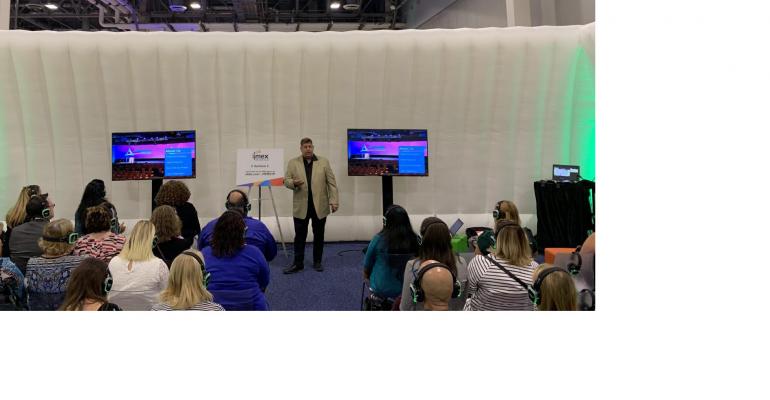In an interesting inflatable seminar space on IMEX America’s show floor, Scott Frankel, president of Animatic Media, offered insider advice on how meeting planners should handle the negotiation and execution of AV for their events.
Frankel didn't mince words, in fact. Early on, the 25-year veteran said this: “Some of you meeting planners are too nice when you’re handed those AV contracts from exclusive in-house providers—you just sign them!” Instead, he recommended that planners “ask for every related document ahead of signing the provider’s standard contract and get prices for electrical fees and everything else because most elements are negotiable.”
He cited items such as liaison fees, patch fees, and storage fees as opportunities for planners to ask, “Why am I paying this? What do I get for it?” And regardless of the answer, Frankel said that “you can play hardball and ask to have those greatly reduced. Make a counteroffer for each one.” Also, asking for extra set-up time before an event at no charge is something many venues will agree to if a planner is firm about it.
As for the personnel required on site to keep all production elements running smoothly, he suggested that larger meetings employ what’s called an A2—an assistant to the audio engineer. The reason: The engineer cannot leave the sound board to fix any problems that happen during a general session, and the A2 can also run to nearby breakouts that need technical assistance. What’s more, Frankel sets a ratio of one “floater” for every three breakout rooms. “Don’t push that ratio, or it will take too long for the floaters to get to a breakout session and fix a glitch.”
Frankel noted that strategic collaboration with the AV provider ahead of an event can bring about a better experience for attendees while minimizing costs for the host. Here are his related tips:
- For general sessions, communicate to the AV provider the goals of the presenters and the type of experience they want the audience to have. From this, the provider can give ideas on the types of lighting to make it happen. “Simple lighting can transform a room,” Frankel said. “It does not always have to be rigged from above or expensive.”
- Add a downstage monitor (also called a “confidence” monitor) so that speakers don’t have to turn their backs to the audience to know what’s on the screen. “It makes presentation quality noticeably better,” Frankel said.
- Give the AV provider information on any audience-response systems or social-media feeds that will be incorporated into the session, so they can plan out where screens should be placed to present that information.
- Think about how many cameras you’ll need to show session close-ups to those in the room and to send the feed to attendees in spillover rooms. These cameras will likely differ in type and in set-up location from any cameras you use to record the session for future online viewing.
- Because microphones are expensive and can wreak havoc on AV budgets, think through the flow of general sessions so that you can limit their number. For instance, try not to have a panel discussion take place in a time slot between presentations unless there is a break that allows you to redistribute mikes. Also, request “combo kits” so the audio engineer can switch back and forth between handhelds and lavaliers quickly. Lastly, “audio needs different laptops for room music and for presentations, plus at least one backup unit,” Frankel said.





